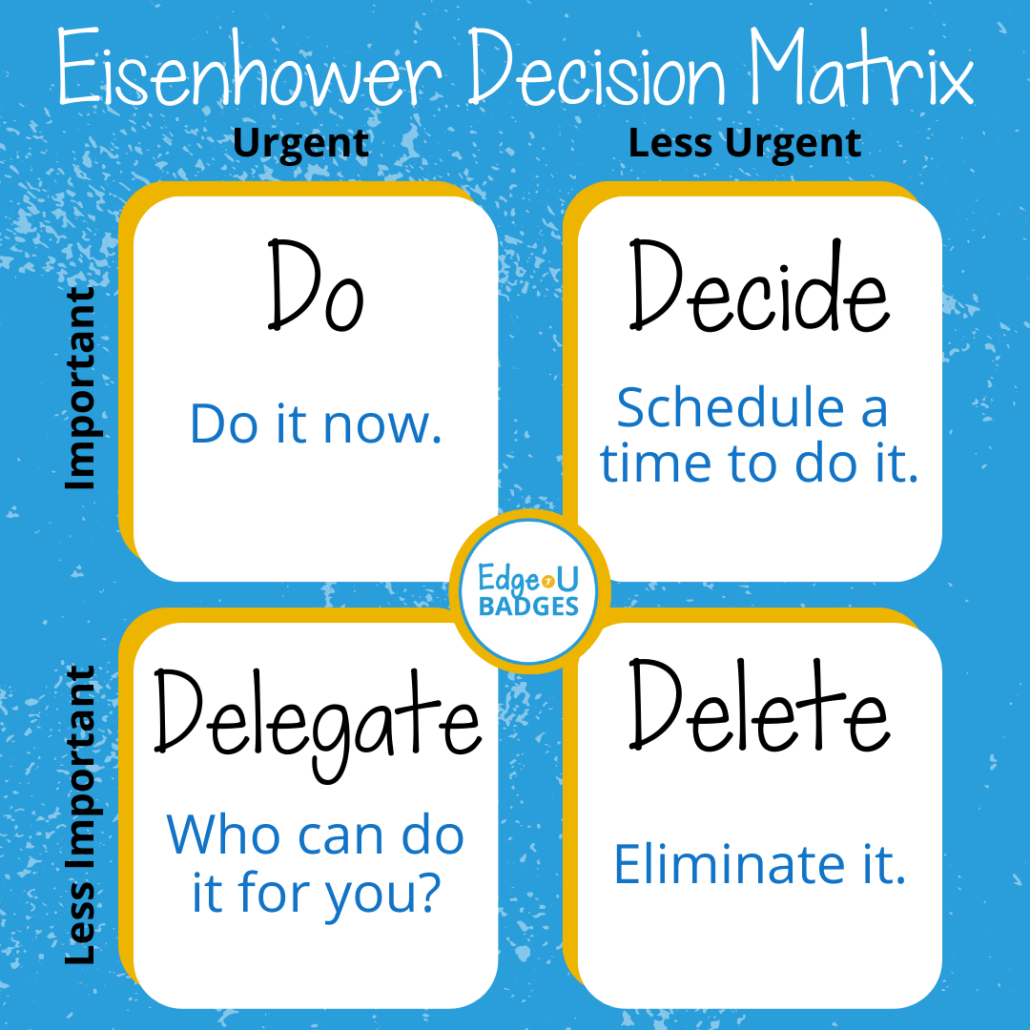Master your To-Do List with the Eisenhower Matrix
Master your To-Do List with the Eisenhower Matrix
“My list is long and growing!”
“How will I EVER get through all of this?”
You are already feeling overwhelmed and have no idea where to start. It should be simple, right? Just take one step at a time, look it all over, prioritize what needs to be done, and begin to chip away at the tasks. Instead, you blankly stare at the considerable assignments and a slow panic begins to threaten your productivity.

Concentrating on prioritizing tasks is a crucial aspect of managing your time effectively. You CAN focus on the most important and urgent tasks, which helps you stay productive. One beneficial tool for arranging tasks is the Eisenhower Decision Matrix, named after Dwight D. Eisenhower, the 34th President of the United States. Eisenhower was a man who faced difficult decisions every day, with both personal and professional aspects. The Eisenhower Decision Matrix is based on two simple questions:
- Is this task important?
- Is this task urgent?
If a task is both important and urgent, then it should be done immediately. If a task is important but not urgent, then it could be scheduled for a later time. If a task is urgent but not important, then it could be delegated to someone else. And if a task is neither important nor urgent, then it should be eliminated altogether. This has proven to be helpful for anyone who desires to self-manage visions and goals successfully.
This may sound like a great plan, but how can you make this matrix work for your circumstances? Here are a few suggestions as a guide to get you started:
- Avoid feeling overwhelmed and insufficient. When you have many tasks to complete, it can be easy to feel unsure of where to start. Be honest with yourself about the importance of each task. You can prioritize tasks based on their urgency. This helps you to focus on the tasks that need to be done first and can reduce feelings of stress and overwhelm. Not everything has to be perfect, nor does it need to be accomplished in one day!
- Improve your personal productivity. Prioritizing tasks can also help you to be more productive. When you know which tasks are most important and urgent, you can focus on them first and complete them efficiently. Schedule your time for important tasks, even if they are not urgent. Take breaks throughout the day to avoid burnout or additional stress. This can help you to get more done in less time and feel more accomplished at the end of the day.
- Make better decisions. The Eisenhower Decision Matrix can help you better prioritize your tasks so you can spend time on the things that matter most. By categorizing tasks into four quadrants based on their importance and urgency, you can make more informed decisions about which tasks to tackle first and which ones can wait. Learn to say ‘not right now’ to requests that are not time-sensitive or high-priority. Don’t be afraid to delegate manageable tasks to other team players. This can help you to be more strategic with your time and make the most of each day.
We live in a constantly changing world that perpetually distracts us from seeing our full potential. Using the Eisenhower Decision Matrix can help you to prioritize tasks based on their importance and urgency, avoid feeling overwhelmed, improve productivity, and make better decisions about how to spend your time. Let’s carry on with endurance and lean into the words Eisenhower himself famously said: “In preparing for battle I have always found that plans are useless, but planning is indispensable.”
Edge•U Badges provides an innovative and effective approach to professional learning, empowering educators to grow and succeed in their field of expertise, and allowing voice and choice in deciding what strategies and tools will best impact student learning. This platform enables teachers and leaders to learn at their own pace, providing them with the flexibility to fit professional development into their busy schedules. The badges also provide clear success criteria for measuring progress, allowing teachers to track their own growth and see tangible evidence of their achievements. This, in turn, fosters a sense of personal accomplishment and excitement among all teaching professionals, creating a culture of continuous learning and improvement. Take control of your professional development to-do list and enhance your practice with efficiency and confidence!
